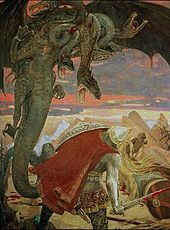- Slavic dragon
-
"Zmaj" redirects here. For the Serbian poet, see Jovan Jovanović Zmaj.
 Zmey Gorynych, by Viktor Vasnetsov
Zmey Gorynych, by Viktor Vasnetsov
In Slavic mythology, the word “zmey” (Bulgarian and Russian: змей, Macedonian: змеj) and its cognates zmiy (Ukrainian: змій) and zmaj (Serbian: змај, Bosnian, Croatian, Slovene: zmaj), are used to describe a dragon. These words are masculine forms of the Slavic word for "snake", which are normally feminine (like Russian zmeya). In Romania, there is a similar figure, derived from the Slavic dragon and named zmeu. Exclusively in Polish and Belarusian folklore, as well as in the other Slavic folklores, a dragon is also called smok (смок, цмок, smok). In South Slavic folklores, the same thing is also called lamya (ламйа, ламjа, lamja). Although quite similar to other European dragons, Slavic dragons have their peculiarities.
Contents
East Slavic
In Ukraine and Russia, a particular dragon-like creature, Zmey Gorynych (Ukrainian: “змій Горинич” or Russian: “змей Горыныч” ), has three heads, is green, walks on two back paws, has small front paws, and spits fire. According to one bylina, Zmey Gorynych was killed by Dobrynya Nikitich.
Other Russian dragons (such as Tugarin Zmeyevich) have Turkic names, probably symbolizing the Mongols and other steppe peoples. Accordingly, St George (symbolizing Christianity) killing the Dragon (symbolizing Satan) is represented on the coat of arms of Moscow. Some prehistoric structures, notably the Serpent's Wall near Kiev, have been associated with dragons as symbols of foreign peoples.
Russian dragons usually have heads in multiples of three. Some have heads that grow back if every single head isn't cut off.
South Slavic
In Bulgaria, Macedonia, Croatia, Bosnia and Herzegovina, Serbia and Montenegro, there is a division between two types of dragon-like creatures: zmaj/zmej and aždaja.
Zmaj/Zmej
In Slovenia, a dragon is called zmaj, although an archaic word of unclear origins, pozoj, is sometimes used as well. Dragons in Slovenia are generally negative in nature, and usually appear in relation with St. George. Other, presumably pre-Christian folk tales relate stories of dragons defeated similarly as the Polish Wawel Dragon, by feeding them with sulphur stuffed sheep. However, the dragon is not always harmful to man. The best example of this is the Ljubljana Dragon, who benevolently protects the city of Ljubljana and is pictured in the city's coat of arms.
In all the South Slavic folklores, a dragon is called zmaj, zmej (змей,змеј) or lamja (ламя,ламја). It is considered as "extremely intelligent, wise and knowledgeable" creature of "superhuman" strength and proficiency in magic, very rich (usually described as having castles of enormous riches hidden in distant lands) and often lustful for women, with whom it is capable of making offspring. It often breathes fire and is generally accepted as a highly respected being, and while not always being benevolent, never as an entirely evil creature. Legends were spread about many historical and mythical heroes that they were conceived by a dragon.
Some famous national heroes were considered to be dragons in the respective national folklore. One of the best examples for this claim is Vlad III Dracula[citation needed], who was a member of the Order of the Dragon. Another example would be Husein-Kapetan Gradaščević, a successful Bosniak general who fought for Greater Bosnian independence from the Ottoman Empire. He is often referred to as "Zmaj od Bosne", meaning "The Dragon of Bosnia". The Serbian Despot Vuk Grgurević was also known as 'Zmaj-Ognjeni Vuk' (Vuk the Fiery-Dragon) because of the viciousness of his reign and victorious battles he waged against the Turks. There is also an ancient type of dog in Serbia sometimes referred to as the "Zmaj" by its keepers, but it bears no relation to the mythical reptiles apart from being immortalized in Sylvanian folklore as the protector of man against "dragons" and other evils.
Aždaja
Aždaja or aždaha, sometimes ala or hala is generally considered to be a creature separate from dragons and a polar opposite to them in its nature. It is a being of pure evil, a dragon-like beast and dreadful monster with no reason, that usually lives in dark and hostile places, or guards unreachable locations in fairy-tales. It is often multi-headed (with 3, 7 or 9 heads) and breathes fire. In Christian mythology and iconography, the famous St. George icon is described as 'slaying the aždaja/aždaha', and not a zmaj.
See also
- Chuvash dragon
- Smok Wawelski - dragon of Kraków
- Zahhak (or Aži Dahāka) - Iranian dragon
- Zilant - dragon of Kazan
- Zirnitra - Wendish dragon and god of sorcery
- Dobrynya Nikitich and Zmey Gorynych (2006 animated feature film)
Slavic mythology Major gods Other gods Legendary heroes Magical creatures and plants Alkonost • Cikavac • Firebird • Fern flower-Chervona Ruta • Gamayun • Ispolin • Kolobok • Raskovnik • Simargl • Sirin • Ved • ZmeySpirits and demons Ala • Baba Yaga • Bagiennik • Bauk • Black Arab • Bannik • Bies • Blud • Boginki • Bukavac • Chort • Dola • Domovoi • Drekavac • Dukljan • German • Damned Jerina • Karzełek • Kikimora • Koschei • Lady Midday • Leshy • Likho • Likhoradka • Ovinnik • Polevik • Psoglav • Rusalka • Shishiga • Samodiva • Skrzak • Solovey-Razboynik • Stuhać • Sudice • Topielec • Vampir • Vesna • Vila • Vodyanoy • ZduhaćOther Films based on Slavic mythology • Polish folk beliefs • Russian traditions and superstitions • Serbian folk astronomy • Ukrainian folklore • Book of VelesCategories:- Slavic legendary creatures
- Russian mythology
- Dragons
- Magic (paranormal)
- Characters in Bylina
Wikimedia Foundation. 2010.
